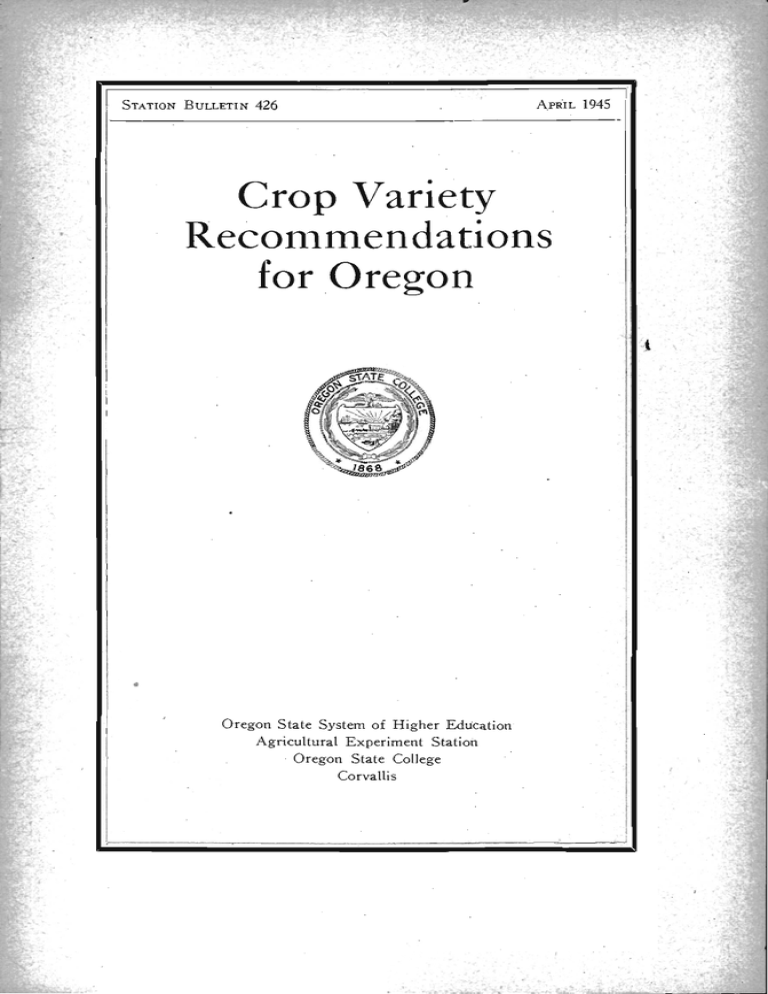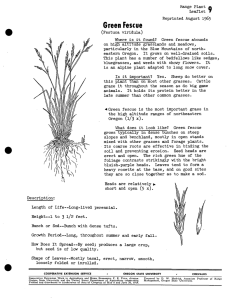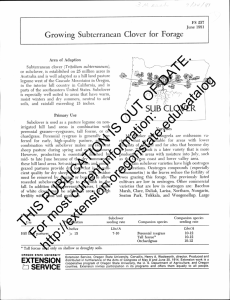Crop Variety Recommendations for Oregon W
advertisement

W
APRIL 1945
STATION BULLETIN 426
Crop Variety
Recommendations
for Oregon
Oregon State System of Higher Education
Agricultural Experiment Station
Oregon State College
Corvallis
FOREWORD
Oregon produces a large variety of crops as
a result of wide range of environmental conditions. Each crop and each variety has certain
conditions where it does best. For each specific
condition in the state one variety is usually superior to others. Farmers will generally grow high
yields of better quality by growing the, standard
adapted varieties. This publication is an attempt
to indicate the varieties and crops best suited to
certain areas. It does not include all crops or
even all varieties that might be grown. It merely
gives the varieties of the commonly grov1n crops
that experimental tests and farm experience indi-
cate are the best ones for specific areas. The
recommendations represent the combined j udgment of the Farm Crops staff, the Branch Experi-
ment Station superintendents, and the LTnited
States Depaitment of Agriculture cooperators.
Wir. A. SCHOENFELD
Director
Table I.
Crop
CEREAL AND FORAGE Csor VARIETIES ADAPTED TO VARIOUS GEOGRAPHICAL LOCATIONS IN OREGON
W=winter; S=spring
\9'illamette Valley
Coast Region
Wheat
Holland (W)
White Winter ('N)
Zimmerman (S)
Marquis (S)
Huston (S)
Oats
Gray Winter ('N & S
Victory CS)
Schoolmam (S)
Santiam
OAC No. 7 (%V or 5)
Barley
('1751)
Hannchen (S)
Columbia Basin .and
Blue Mountains
Rio (%'I)
Rex (W)
Elgin (W)
Golden (W)
Federation (5)
Hd. Federation
No. 31 (S
Wh. Federation (5)
Baart (5)
Carlton (S)
Markton (S)
Trebi (5)
Flynn 37 (S)
Meloy CS)
Club Mariot (S)
Red clover Cumberland
Grimm
Pasture grasses
Alta fescue
Meadow foxtail
Tall oatgrass
Orchard grass
Chewings fescue
Illahee red creeping
fescue
Perennial ryegrass
(U.W.-Klam)
'Nh. Federation 38 CS)
Victory (5)
Kanota (5)
Trebi (5)
Flynn 37 (5)
Velvon (5)
Ladak
Ladak
Ranger
Orestan
Local common
Highland bent
Meadow foxtail
Alta fescue
Perennial ryegrass
Orchard grass
Astoria bent
Red creeping fescue
Crested wheatgrass
Big bluegrass
Slender wheat
(Temporary)
Smooth brome
Beardless wlseatgrass
Smooth brome
Meadow foxtail
Alta fescue
Alta fescue
Perennial ryegrass
Meadow foxtail
Tall meadow oatgrass
Orchard grass
Ore. 525
Ore. 355
Ore. 525
Ore. 525
Ore. 570
Ladino clover
Subterranean clover
Alfalfa
Lotus uliginosus
Subterranean clover
Ladino clover
Ore. 570
Ore. 100
Pasture legumes
Victory (5)
Kanota (5)
(Klamath Falls)
Bannock (S)
Trebi (5)
Hannchen (5)
Southern Oregon
Federation ()
Midland
Alfalfa
Corn
Central Oregsn
(Irrigated)
Federation (5)
'A'h. Federation
38 (5)
Baart (38) (5)
Elgin (W)
Seed supply is very short.
Ranger
Minn. 13
Coos
County
Orchard grass
Tall meadow oatgrass
Union and
Idahybrid 544
Iowealth 16
Iowealth AQ
Ore. 695
Ore. 525
Idahybrid 544
Idahybrid 416
Sweet clover (draws)
Ladino clover
Alfalfa
Lotus corniculatus
Ladino clover
Alfalfa
Alfalfa
Baker counties
Subterranean clover
Crop Variety Recommendations
for Oregon
are produced- in Oregon under a wide range of soil and
The soils vary from almost pure sand to
very heavy adobe. C-rops are grown at sea level and at all elevations
up to 8,000 feet. They are grown under conditions of from less than
10 inches to more than 100 inches of annual rainfall and in regions
where winter and summer temperatures are mild to regions where
winters are extremely cold and the summers may be very warm. As
CROPS
climatic conditions.
a consequence, Oregon is in a position to grow all of the crops
adapted to the North Temperate Zone.
Because of rather distinct geographical divisions it is possible
to divide Oregon into certain regions according to the general plant
production environmental conditions. It is also possible to make
varietal recommendations for these general areas. Within each area,
however, - certain conditions make it necessary to make different
varietal recommendations within the area. Table 1 gives the major
varietal recommendations for each of the areas. Special recommendations are given in the following discussion.
Coast Region
The Coast Region is primarily a pasture region. Cereals and
hay crops are not commonly grown. One oat variety is recommended
for hay production because of its rust resistance. One barley variety
is recommended for production in the Coos Bay area. On wet lands
for pasture, a mixture of meadow foxtail, Alta- fescue and Lotus
uliginosus, also known as Lotus major; are the best of those recommended. Ladino clover should be grown only under irrigation or
on naturally moist bottom lands and then in mixture with such
g'rasses as meadow foxtail and perennial ryegrass. On lands infested
with bracken fern a mixture of Alta fescue, creeping red fescue, and
Lotus major show great promise when aided in starting by applica-
tions of nitrogen and phosphorus or manure. A small amount of
Oregon 525 corn is grown in Coos County. -
Willarnette Valley
Winter cereals will commonly outyield spring cereals in the
Willamette Valley on lands where they can be grown. Winter wheat
and winter barley should not be grown except.on well-drained lands
The recommendations in this publication are based on experiments conducted at the
central and branch experiment stations -and on experiences of farmers throughout the state.
The Farm Crops staff, the Branch Experiment Station superintendents, and representatives
of the U. S. Department of Agriculture have collaborated in the preparation of -this material.
STATION BULLETIN 426
6
and on lands not subject to excessive overflow. A wide variety of
pasture grasses can be grown. In general Alta fescue is adapted to
all deep soils in the Willamette Valley. Chewings fescue, on the
other hand, will produce relatively better on the shallower hill soils.
Oregon 100 is recommended as an early-maturing corn variety for
early fall feed and for areas requiring exceptionally early maturity.
Columbia Basin and Blue Mountains
Rio is the only recommended Turkey wheat variety. It is satisfactory from a quality standpoint, has considerable smut resistance,
and is equal to or superior to all other Turkey types. It should be
grown in those drier sections where high protein winter wheat can be
grown. Rex is probably the most widely adapted wheat grown in the
Columbia Basin. It is smut resistant and high yielding. Millers
discriminate against Rex because of milling quality. Elgin appears
to be widely adapted throughout most of the Columbia Basin. It is a
soft white wheat that appears to be acceptable to specialty flour
millers. It has no smut resistance. Golden is a nonshattering Forty-
fold type that should replace the original Fortyfold. Of the. spring
wheats, to avoid mixtures, the variety should be grown that iscommon to the area.
Barley varieties for the Columbia Basin depend on rainfall.
Trebi is best adapted in regions of higher rainfall. Flynn 37 is a
smoothawned variety and is a very high yielder throughout most of
the region. Meloy is the highest yielding hooded variety. In most
parts of the Columbia Basin barley will equal. or exceed wheat in
yield.
Oats are of minor importance as this crop will produce fewer
pounds per acre than wheat or barley.
Crested wheatgrass is the outstanding grass for the dry lands of
the state. It can be established wherever a fair seeclbed can be prepared. Once established this grass can be maintained for many years
by proper management. The other grasses recommended are either
shorter-lived or require more favorable moisture conditions.
The choice of legumes for dry land is limited. Alfalfa and sweet
clover can be grown under the most favorable conditions.
Corn hybrids Oregon 525 and 570 are adapted to the sections of
Baker, Union, Sherman, Wasco, and Hood River counties in which
corn is grown.
Central Oregon (irrigated)
-
The varieties recommended are for the irrigated regions, principally Malheur County, Hermiston, the Redmond-Prineville area,
CROP VARIETY RECOMMENDATIONS
7
and the Klamath Basin-Lake County region. The longer growing
season and higher temperatures in the Maiheur and Hermiston regions permit the growth of some varieties not suitable to the other
areas and vice versa.
Federation is a desirable wheat for all areas except where rust
is a factor. Because of its rust resistance Baart 38 has become a
popular variety in Klamath.
Kanota oats is recommended only in Klarnath. This variety
resists lodging better than the others on the more fertile soils.
Hannchen barley is grown in Klamath primarily because of its
desirability for malting purposes. Other varieties will generally outyield it under irrigation.
Of the alfalfa varieties listed Orestan and Ranger have the most
wilt resistance. Ranger is a new variety developed by the United
States Department of Agriculture; it appears to have a wide adaptation.
Corn is successfully grown only in the Malheur and Hermiston
regions. The varieties best adapted are midseason and late-maturing
types.
Southern Oregon
Spring grains are generally superior to fall grains in southern
Oregon. Where there is a shortage of water, fall planting is preferiViany spring varieties can be fall planted successfully in many
The best corn varieties are those midway between the Willamette Valley types and those grown in Malheur. Ladino clover
and Lotus are well adapted to the region. Subterranean clover offers
promise, especially in Douglas County. Of the grasses recommended,
able.
areas.
perennial ryegràss is suggested as a desirable grass to grow with
Ladino clover under irrigation. Meadow foxtail requires either wet
land or irrigation. The others may be grown on dry land but do best
when water is available.



